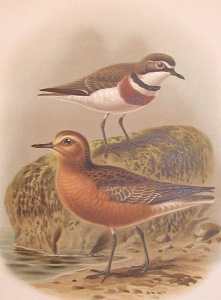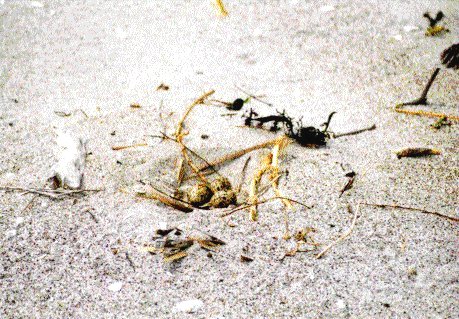
— Notes on the New Zealand Dotterel in Eastern Bay of Plenty —
by Bill Sloan, OSNZ, (1924-2005).
With the exception of a few birds on the east coast in the Gisborne area and the very odd bird on the west coast, the Bay of Plenty is as far south as the northern sub–species of the N.Z. dotterel, aquilonius, is found. It is estimated that there are about 1,350 of this subspecies and rather less than 100 of the southern obscurus subspecies which is found on Stewart Island and which is a slightly larger bird. In the eastern Bay of Plenty the birds nest on the dunes at several estuaries in the Opotiki area, namely those of the Waiotahi, Waioeka and Waiaua rivers where they have been extensively studied over recent years by Mr A Glaser of the Department of Conservation. They also nest at Ohiwa harbour further west and at Whangaparaoa near Cape Runaway.
Trapping of potential predators has been carried out by D.O.C over recent years in the Waiotahi, Waioeka and Waiaua areas — the principal predators caught being hedgehogs, stoats, and weasels. The population of black–backed gulls, Larus dominicanus, is reduced when they become dangerous to eggs or chicks. I have noticed that quite often three chicks are hatched but are quickly reduced to two — the parents being unable to protect the third. Over recent years the population of spur–winged plover, Vanellus miles, has greatly increased and they are often to be found in large numbers in the dotterel nesting areas. Although there are records of these birds molesting chicks their principal detrimental effect is interference with the chicks’ access to food.
As a result of Mr Glaser’s work it has been shown that a dotterel having lost its nest through predation or any other cause will frequently nest again, if necessary, two or three times.
Through banding it has been proven that fledglings disperse quite widely, a bird hatched and banded at the Waiaua estuary was seen at Pollen Island in the Waitemata Harbour area.
After nesting the local dotterels flock at Ohiwa Harbour, starting to assemble usually in late February. In recent years this flock, at its height, has amounted to around 70 birds. It usually starts to disperse in May. For some reason they seem to populate the furthest of the three estuaries, Waiaua first. The birds are very territorial and much squabbling takes place when a bird encroaches on someone else’s patch.
It is suspected this year that there may be a female/female pairing at the Waiotahi Estuary. It is know that there are only two pairs at this location but there are three nests containing eggs.It is possible that one nest has been abandoned and the pair re nested but this is not thought to be the case. Advantage has been taken of female/female pairings in places where the birds are particularly scarce by robbing nests which will be replaced by fertile hens and giving the eggs to the unmated bird to incubate.
Six years ago a stoat den with kits was found at Waiaua and on analysis the remains of 11 dotterels were identified; since the stoat probably hunted over night and the male bird is known to incubate at night a disproportionate number of pairs would have been broken. However it seems that there must be a “pool” of birds somewhere possibly local fledglings because in the season following the number of birds breeding at Waiaua was back to the usual 6 or 7 pairs.
One advantage that the dotterel nesting areas in this region have over many of those further north is that they are not plagued by holiday makers to any great extent; in some places unless chicks are fledged by Christmas little hope is held out for their survival as a result of human interference.

— Notes on the New Zealand dotterel around Matata —
by John Groom, member Forest & Bird.
A bird with some fascinating habits, Tuturiwhatu live only on beaches or sand bars round lagoons. Nesting between early September through to the end of February, they usually choose an area on a wide beach, preferably with good visibility, often near streams or access to fresh water. Most times, the simple nest scrape is against a small patch of drift wood or seaweed. Three eggs are laid over several days, incubation taking 30 + days.
Because of predators (rats, hedgehogs, stoats, gulls, hawks, cats, dogs,) 4 wheel drive vehicles, wave action during storms, picnickers close to nests preventing incubation, very few fledge. However, Tuturiwhatu will lay again, often just 3 weeks after a loss. Last season several pairs I monitored laid 4 times. Twelve eggs is more than the adult body weight so those unsuccessful breeders do not live a long life. Males also have their lives shortened as they do the night shift incubation when the majority of the predators are active.
I find an endearing habit is the male running to greet an intruder invading his chosen territory. Also, if I start moving driftwood or flotsam, I get interested spectators. Dotterels very closely inspect any change to their territory.
To lure away human invaders, they will frequently run in front of you, semi–crouched with the head turned back to make sure you are following. If that is unsuccessful the broken wing ploy is tried. I have witnessed a dotterel chase a black back gull, a white face heron, a paradise shellduck and even a pair of variable oystercatchers that came too close to its eggs.
Frequently dotterels and oystercatchers nest in close proximity and do a very good job minding intruders to stay out of their nest area. I have witnessed a male dotterel trying to turn a oystercatcher egg while the parent birds were away feeding.
Last season I monitored 35 eggs from seven pairs of dotterels. One chick lived to fly. This in spite of notice boards on the beach, predator trapping, and poison baits for rats.
Other common names: —
Red–breasted dotterel.
Description: —
Endemic bird
25 cm., 160 g., breeding adult, upper parts brown, streaked with dark brown with whitish feather edges, underparts from pale buff to rich red; non breeding, nondescript.
Where to find: —
Beaches of Northland, Auckland, Waikato and Bay of Plenty and obscurus on Stewart Island.
Youtube video —
Poetry: —
Dotterel
Wild and impermanent
as the sea-foam blown,
the dotterel keeps its distance
and runs alone.
Bare beach, salt wind,
its loved solitude,
hold all that it asks
and shelter and food.
I saw its single egg
dropped on the sand,
and neither straw nor wall
to warm or defend;
and the new-hatched chick,
like a thistle’s pale down,
fled and crouched quiet
as sand or as stone.
Water’s edge, land’s edge
the edge of the air –
the dotterel chooses
to live nowhere.
It runs, but not in fear;
and its thin high call
is like a far bugle
that troubles the soul –
— Judith Wright
Credit for the photograph: —
Rosemary Tully
Illustration description: —
Buller, W.R., Birds of New Zealand, 1888.
Reference(s): —
Heather, B., & Robertson, H., Field Guide to the Birds of New Zealand, 2000.
Page date & version: —
Thursday, 29 May 2014; ver2009v1

